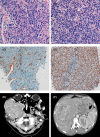Doege-Potter syndrome in a facial solitary fibrous tumor: Diagnose and clinical management discussion
- PMID: 34194795
- PMCID: PMC8222743
- DOI: 10.1002/ccr3.4291
Doege-Potter syndrome in a facial solitary fibrous tumor: Diagnose and clinical management discussion
Abstract
Doege-Potter syndrome is a rare hypoglycemic paraneoplastic disorder. This case describes that severe and symptomatic hypoglycemia can occasionally be due to a rare malignant neoplasm, and the differential diagnosis of malignancy should not be overlooked in this setting.
Keywords: Doege‐Potter syndrome; STAT6; big‐IGF2; hypoglycemia; paraneoplastic syndrome; solitary fibrous tumor.
© 2021 The Authors. Clinical Case Reports published by John Wiley & Sons Ltd.
Conflict of interest statement
None declared.
Figures

References
Publication types
LinkOut - more resources
Full Text Sources
Research Materials
Miscellaneous

